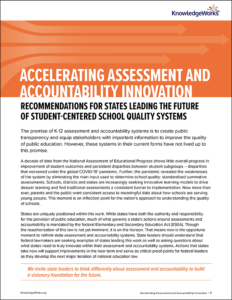The federal government requires states to design accountability systems that collect and report annual school performance data on academic proficiency, academic growth, graduation rates and progress toward English language proficiency. States must also select a measure for elementary schools and
at least one measure of school quality and student success. Collectively, states use this information to identify schools performing in the bottom 5% as well as those with the largest and most persistent disparities between subgroups of students. This framework was designed to equip stakeholders with valuable information to drive resources and supports to the students who need them the most. Unfortunately, these policies have not led to the equitable outcomes policymakers had hoped and stakeholders are raising important concerns about their impact.
Common stakeholder concerns about school accountability systems
- Required indicators rely heavily on standardized assessment data and do not represent a comprehensive picture of school quality
- The heavy emphasis on student outcomes masks important inputs that play a significant role in student opportunity to learn
- Communities do not have the ability to incorporate measures that align to their visions and local values
- Districts are not held accountable for performance despite the significant role they play in managing school quality
- Access to data and supports is not timely and often comes too late to help students when challenges emerge
- School identification strategies can stigmatize communities and encourage families with the economic means to seek other options
These concerns indicate a need to explore new approaches to school accountability, yet federal law does not provide states with a pathway to test and evaluate new approaches. This is a significant barrier for states seeking to advance new visions for education – particularly those ready to think boldly as they address the impacts of the COVID-19 pandemic. Without federal action, the only path forward is to run concurrent state and federal accountability systems – one that aligns with the state’s vision for educational transformation, and one that complies with federal requirements. This outcome is far from ideal as it upsets system coherence and has historically led to stakeholder confusion when some states developed parallel systems prior to enactment of the Every Student Succeeds Act in 2015.
Federal action is needed to chart a new path for school accountability that begins with a focused opportunity for states to pilot new approaches. The following recommendations provide a framework for how federal policymakers should structure this opportunity.







